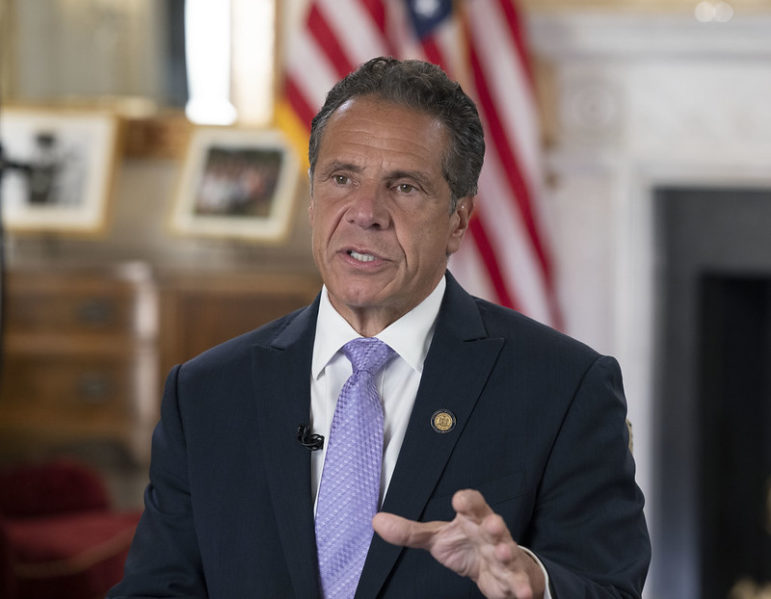The new report also details how former Gov. Andrew Cuomo used state resources, including personnel, to publish his 2020 book, flouting state policy in the process.

Mike Groll/Office of Governor Andrew M. Cuomo
Gov. Andrew Cuomo during a virtual event in July.The New York State Assembly Judiciary Committee released the findings of its monthslong impeachment investigation of former Gov.Andrew Cuomo on Monday, corroborating many of the same allegations detailed in an attorney general’s probe released this summer, which prompted Cuomo’s resignation.
The committee’s findings evidence how the three-term governor not only sexually harassed women—including a trooper on his detail and a staffer who reported that he groped her breast—but that he used state resources to publish and promote his book, and that he “was not fully transparent” on the number of nursing home residents in the state who died from COVID-19.
Investigators at Davis Polk & Wardwell, the law firm tasked with conducting the probe, reviewed around 600,000 pages of documents, among them emails, text and BlackBerry messages, photographs, recordings, memos, and transcripts.
“We conclude that there is overwhelming evidence that the former Governor engaged in sexual harassment,” the investigators wrote at the start of the more than 60-page report.
Cuomo, who resigned in late August, making way for then-Lt. Gov. Kathy Hochul to become the state’s first woman governor, has repeatedly denied the sexual harassment allegations, claiming they were politically provoked.
The former governor, who was readying a fourth-term bid before his resignation, did not immediately address Monday’s report, though he has repeatedly denied and sought to discredit the findings of previous investigations into his conduct, including the August report published by Attorney General Letitia James’ office. Cuomo was given the opportunity to provide written submissions to the Assembly committee, the new report says; Davis Polk & Wardwell investigators said they have “reviewed the former Governor’s challenges to the allegations, and nothing in his voluminous submissions can overcome the overwhelming evidence of his misconduct.”
The new report also details how Cuomo used state resources, including personnel, to publish his 2020 book “American Crisis: Leadership Lessons from the COVID-19 Pandemic,” flouting state policy in the process. Cuomo, who “profited substantially” from the book, minimized the gravity of his earnings from the project, the investigators found. Contrary to his public claims, his contract guaranteed him $5.2 million in royalty advances, according to the report, with additional compensation promised if the book met certain sales figures.
“Certain senior state officials worked extensively on the Book, including attending meetings with agents and publishers, transcribing and drafting portions of the Book, coordinating the production and promotion of the Book, and participating in working sessions to review and finalize the Book,” said the report.
“This work was done as part of the regular course of work in the Executive Chamber, including during normal work hours. One senior state official explained that Book-related assignments were given by superiors and expected to be completed, and the work was not voluntary,” the report states, contradicting claims by Cuomo’s team that staffers volunteered to work on the book, and did so on their own time. “Another senior state official complained in a text message to a colleague that work on the Book was compromising the official’s ability to work on COVID-related matters.”
Additionally, the investigators found that Cuomo and the executive chamber “substantially revised” a state Department of Health report on nursing home infections and fatalities related to COVID-19 to “combat criticisms regarding former Governor Cuomo’s directive that nursing homes should readmit residents that had been diagnosed with COVID-19.”
Ultimately, the investigators said, state officials published a report that focused only on nursing home residents that died in nursing homes, not in “out-of-facility” locations, like the hospitals patients might have been transferred to before dying. The final report, as a result, “was not fully transparent,” the investigators said.
“While the Executive Chamber and certain witnesses have explained that there are several possible reasons for choosing to report in-facility deaths only, including questions regarding the reliability of data regarding out-of-facility deaths (which was more difficult to collect and verify than in-facility deaths), certain witnesses have stated that a reason for including in-facility deaths only was because including the higher number would have distracted from the overall message of the DOH Report and would have also been inconsistent with data that had been publicly reported at the relevant time,” the report said.
You can read the full impeachment investigation report below.
Impeachment Investigation Report to Judiciary Committee Chair Charles Lavine and the New York State Assembl… by Jeanmarie Evelly on Scribd








